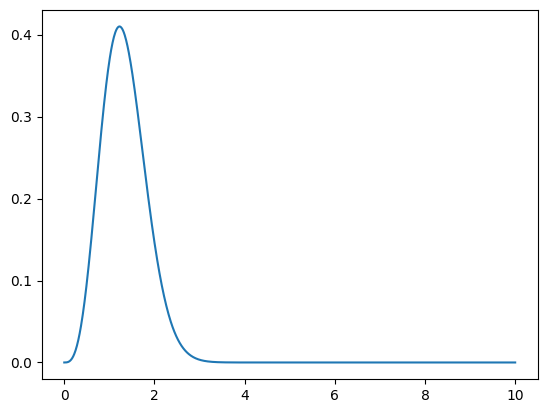Homework 2 solutions#
1#
We want to extend Simpson’s rule to work with an odd number of intervals. In class we found that the equation of a parabola that passes through \((x_0, f_0)\), \((x_1, f_1)\), \((x_2, f_2)\) is:
Let’s imagine that we are at the end of the domain, and we just have the single interval \([x_{N-1}, x_N]\) to integrate over.
We can do this by defining the parabola to pass through \(\{x_{N-2}, x_{N-1}, x_N\}\) and then just integrate over the right half.
We’ll follow the SymPy derivation from class (but it is also easy to do this integral by hand).
from sympy import init_session
init_session(use_latex="mathjax")
IPython console for SymPy 1.12 (Python 3.10.14-64-bit) (ground types: python)
These commands were executed:
>>> from sympy import *
>>> x, y, z, t = symbols('x y z t')
>>> k, m, n = symbols('k m n', integer=True)
>>> f, g, h = symbols('f g h', cls=Function)
>>> init_printing()
Documentation can be found at https://docs.sympy.org/1.12/
a, b, c = symbols("a b c")
dx = symbols("\Delta{}x")
fN2, fN1, fN = symbols("f_{N-2} f_{N-1} f_N")
coeffs = solve([Eq(fN2, c),
Eq(fN1, a * dx**2 + b * dx + c),
Eq(fN, 4 * a * dx**2 + 2 * b * dx + c)],
[a, b, c])
coeffs
xN2 = symbols("x_{N-2}")
Here, we change the limits that we integrate over to just be \([x_{N-1}, x_N]\)
I = integrate(coeffs[a] * (x - xN2)**2 + coeffs[b] * (x - xN2) + coeffs[c],
[x, xN2+dx, xN2+2*dx])
simplify(I)
So that would be the contribution to the integral from a single remaining interval if the number of intervals is odd
Let’s write a function that integrates a function, f, from [a,b] with N intervals, where N may be odd.
import numpy as np
import matplotlib.pyplot as plt
def I_s(f, a, b, N):
"""composite Simpsons rule. Integrate f over [a, b]
with N intervals"""
# get the spacing of the intervals
dx = (b - a) / N
I = 0.0
# loop over bins
for n in range(0, N-1, 2):
x0 = a + n * dx
x1 = a + (n+1) * dx
x2 = a + (n+2) * dx
I += dx / 3.0 * (f(x0)+ 4 * f(x1) + f(x2))
# if N is odd, we have one interval remaining
if N % 2 == 1:
x_N2 = b - 2 * dx
x_N1 = b - dx
x_N = b
I += dx / 12.0 * (5 * f(x_N) + 8 * f(x_N1) - f(x_N2))
return I
def f(x):
return x * np.sin(2 * np.pi * x)
def I_analytic():
return - 5.0 / (2.0 * np.pi)
It’s always useful to plot the integrand.
fig, ax = plt.subplots()
x = np.linspace(0, 5, 1000)
ax.plot(x, f(x))
[<matplotlib.lines.Line2D at 0x7f0b784cdd20>]
As we can see, there will be alternating positive and negative contributions, and we’ll need a lot of resolution to get this right.
for n in [3, 5, 9, 17, 33, 65, 129, 257]:
print(f"{n:4} : {abs(I_s(f, 0, 5, n) - I_analytic())}")
3 : 2.5999943066770577
5 : 0.7957747154594665
9 : 1.1876938529724823
17 : 0.06439588165114829
33 : 0.01730255273921677
65 : 0.0017456127932892196
129 : 0.00012529082068590824
257 : 8.22252017085301e-06
2#
We have:
and want to compute:
Let’s start by making this integral dimensionless
Defining
we have
Let’s plot the integrand
def f(x):
return x**3 * np.exp(-x**2)
fig, ax = plt.subplots()
x = np.linspace(0, 10, 1000)
ax.plot(x, f(x))
fig

This actually falls off pretty quickly, but we’ll still use our method for integrating to infinity
SMALL = 1.e-30
def zv(x, c):
""" transform the variable x -> z """
return x/(c + x)
def xv(z, c):
""" transform back from z -> x """
return c*z/(1.0 - z + SMALL)
We’ll do the integration with the trapezoid rule
def I_t(func, N=10, c=5):
"""composite trapezoid rule for integrating from [0, oo].
Here N is the number of intervals"""
# there are N+1 points corresponding to N intervals
z = np.linspace(0.0, 1.0, N+1, endpoint=True)
I = 0.0
for n in range(N):
I += 0.5 * (z[n+1] - z[n]) * (func(xv(z[n], c)) / (1.0 - z[n] + SMALL)**2 +
func(xv(z[n+1], c)) / (1.0 - z[n+1] + SMALL)**2)
I *= c
return I
Now let’s write a function that puts back in the physical units
def avg_vel(T, N=10):
kB = 1.38e-16 # erg/K
m_I = 1.67e-24 # g
return 4 * np.sqrt(2 * kB * T / (m_I * np.pi)) * I_t(f, N=N, c=2)
avg_vel(1.5e7)
That’s a velocity of \(5.6\times 10^7~\mathrm{cm~s^{-1}}\)
The analytic expression is
kB = 1.38e-16 # erg/K
m_I = 1.67e-24 # g
T = 1.5e7
v = 2 * np.sqrt(2 * kB * T / (m_I * np.pi))
v
So we are very close.


